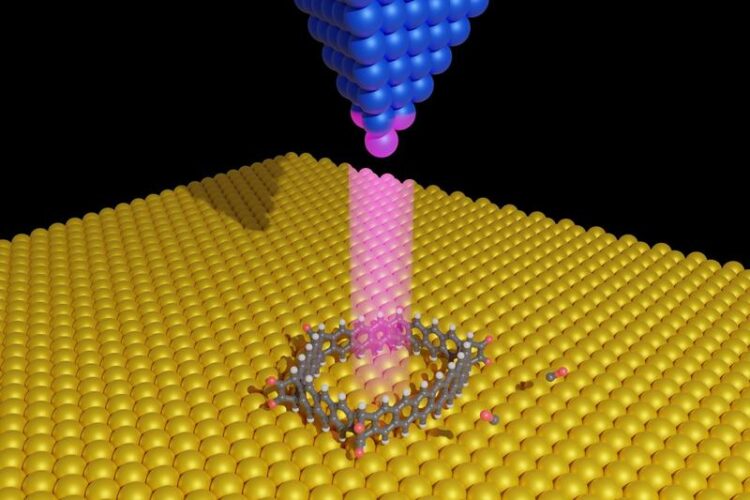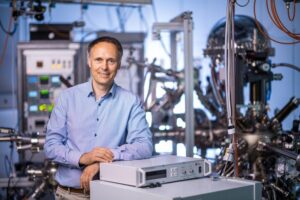Unusual ring-shaped carbon compounds

Manipulation of a cyclacene precursor on a gold surface with electrons from the tip of a scanning probe microscope.
Graphics: Tobias Kirschbaum
… for applications in organic electronics.
Marburg chemist Prof. Dr. Michael Gottfried receives an ERC Synergy Grant.

Photo: Jan Hosan
Marburg chemist Prof. Dr. Michael Gottfried has been awarded an ERC Synergy Grant by the European Research Council (ERC), together with Prof. Dr. Michael Mastalerz from the University of Heidelberg and Prof. Dr. Holger Bettinger from the University of Tübingen. With their project “Tackling the Cyclacene Challenge” (TACY), the three researchers are pursuing the goal of generating a special class of ring-shaped carbon compounds, the cyclacenes, for the first time. The European Research Council is funding the project with around 11 million euros. Of this, around 4.5 million euros is allocated for the research work at Philipps-Universität Marburg.
Cyclacenes are tiny sections of carbon nanotubes and, due to their unique chemical, electronic and structural properties, are of particular importance for potential applications, for example in organic electronics. The ERC-funded collaborative project aims to use new approaches to enable the production of cyclacenes. Despite decades of research efforts, it has not yet been possible to produce even a single representative of this substance class. The researchers now want to achieve this goal, the ‘holy grail’, jointly as part of the TACY project.
“This can only be done as a team and with a combination of completely new ideas,” says Prof. Gottfried, “because there are good reasons why it hasn’t worked so far.” In the laboratory of the surface and nano scientist on the Lahnberge hills, molecular precursors synthesized in Heidelberg and Tübingen will be converted into the desired cyclacenes at extremely low temperatures. This is done on gold surfaces in a so-called scanning probe microscope. With this microscope, individual atoms and molecules can not only be imaged, but also selectively modified. This makes it possible to force chemical processes that would not occur on their own.” By mean of these manipulations, we first want to create individual cyclacene molecules and understand their basic properties,” explains Prof. Gottfried. “With the knowledge gained in this way, we can then go about finding other synthetic pathways that can be used to generate larger quantities.” The researcher is looking forward to a new scanning probe microscope, which will be procured with funds from the ERC Synergy Grant. “It will allow us not only to image and manipulate molecules, but also to analyze them chemically in detail – that’s a great thing and will help us tremendously with the project.”
The European Research Council, or ERC, is the research funding arm of the European Union. The ERC Synergy Grants are among the organization’s four major funding programs.
Wissenschaftliche Ansprechpartner:
Prof. Dr. Michael Gottfried
Department of Chemistry at Philipps-Universität Marburg
Phone: +49 (0)6421 28-22541
E-Mail: michael.gottfried@chemie.uni-marburg.de
Media Contact
All latest news from the category: Life Sciences and Chemistry
Articles and reports from the Life Sciences and chemistry area deal with applied and basic research into modern biology, chemistry and human medicine.
Valuable information can be found on a range of life sciences fields including bacteriology, biochemistry, bionics, bioinformatics, biophysics, biotechnology, genetics, geobotany, human biology, marine biology, microbiology, molecular biology, cellular biology, zoology, bioinorganic chemistry, microchemistry and environmental chemistry.
Newest articles
Faster, more energy-efficient way to manufacture an industrially important chemical
Zirconium combined with silicon nitride enhances the conversion of propane — present in natural gas — needed to create in-demand plastic, polypropylene. Polypropylene is a common type of plastic found…

Energy planning in Ghana as a role model for the world
Improving the resilience of energy systems in the Global South. What criteria should we use to better plan for resilient energy systems? How do socio-economic, technical and climate change related…

Artificial blood vessels could improve heart bypass outcomes
Artificial blood vessels could improve heart bypass outcomes. 3D-printed blood vessels, which closely mimic the properties of human veins, could transform the treatment of cardiovascular diseases. Strong, flexible, gel-like tubes…




















